Calculadoras Calculator blog Mensajes sobre el tema: HP 17bII
Calculator blog
Musings and comments about our common interest
More about the HP17bII
HP 17bII+
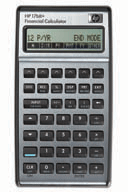
This is probably one of the most underrated calculators in HP's current roster. It has everything one could need from a financial calculator, together with a very well laid out menu system. It has been proven: it has been running in the same style since 1989 if my memory does not fail.
The initial model was totally designed by HP, and was programmed in SysRPL. The current model has been made externally under HP contract, but the firmware was prepared by the producer, in order to fulfill HP's specs. This shows in the different approach taken for the solver. Functionally, both machines are the same, with the difference that the newer one includes an additional menu that takes care of currency exchange calculations. (this menu is of interest unless you have a smartphone, which provides updated currency exchange calculations on the fly)
It only misses the advanced mathematical features of the HP19bII to be perfect. By the way, these features are present in the HP30b, but there the user interface is not as slick as this one. And the way you can program the solver has not been equalled in my experience.
You just need to write something like:
EBIT=UNITS*MARG-PERS-OCOS
(EBIT equals units times margin less personnel costs and less other costs)
The solver will create the corresponding variables, which can be edited at any moment. If you press a number and the menu key of the variable, it gets automatically stored in it; if you press it after another key that is not a number, the solver tries to calculate the value, based on the formula. And there you have a "program" to calculate the break even. you can use it now in boardroom meetings to get a fast idea about how long it will take until your start up starts making profit.
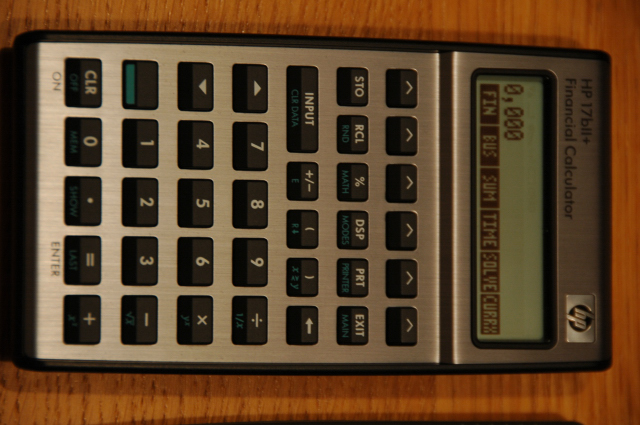
Same happens with the famous Black & Scholes formula. As far as I know, this is exclusive territory of the HP30b; but there are formulae prepared to be entered in the HP17bII, and even on the humble HP12c.
I would say that the main feature of this calculator is the solver, but the rest of the menus are organized in the same way. You can have different lists of money flows or statistical variables, and these lists can be saved, edited and recovered for further work, be it IRR and time value of money calculations, statistical calculations or regression of all kinds.
With the memory it is supplied (28 kbytes), there is no problem in programming additional functions like the trigonometric ones. This programming needs to be done in the solver. It is a pain to enter it the first time, but then you are rewarded with an even more complete calculator. I have never been over 7% use of the memory!
You can get a taste of the hp17bii by downloading the app 17bII+ Financial Calculator by RLM software. However, it is not free: 1 cent short of 7 €, in the Spanish shop.
You will not be able to appreciate one of the best keyboards available for a calculator. By the way, do not let anyone make you think that you smartphone is an alternative for your calculator. I have all free calculator apps, and some of the paying ones, including the ones from HP and the fantastic I41cx+; and while they are good enough to save you from a problem, they are no match for a proper calculator on your desk.
The screen is better than the one from the original HP17bII. The contrast and speed of the screen are incredible.
I will discuss in further blogs the solver and its possibilities. It looks like a full programming language in itself!
Collector's Pack
As many of our visitors are calculator collectors, we have decided to make their hobby easier, by joining all HP calculators in four groups:
- Financial calculators
- Graphical Calculators
- Scientific Calculators
- Other
We are adding all calculators in each group and reducing their price by 20%. In that way, we increase the size of the sale, and you get a significant discount. In the case of the first of them, the financial pack, you save 97,86 €! (apart from lower shipping costs)
The financial pack is composed of:
HP10bII+
HP12c
HP12c Platinum
HP12c Anniversary
HP20b
HP30b
HP17bII
In later days we will complete the offer with the other bundles. I hope you like it!
Two different types of HP19bII
I have now received another calculator for the "harem": an HP 19bII with the back door.
I have fond memories of the HP 19bII. While my first calculators were HP (spice models, beginning with the 33c), I did my last 3 years in university with a Casio pocket computer. At the time, I did not have the funds for the HP41cx - which was the model to have. However, for all practical purposes, the Casio was a better calculator: it could be programmable in Basic and I could do any numerical programming I was asked in my engineering courses. While I missed the powerful Basic of the HP85, with which I made my first money, it was good enough for me.
When I finished engineering I started an MBA. I then got some more money, and I bought the then best available financial calculator - the HP19bII. I enjoyed it during 2 years. It had all the financial tools, plus a good set of statistical and mathematical tools. However, at the middle of my second year in the MBA, it fell to the floor and the battery door went off. I was not able to fix it properly. Tired of sticking it with tape every now and then, I left it in a drawer (from where it was picked up by my sister) and got an HP 17bII instead. A classy machine as well, but missing key features like trigonometrics. Well, it was more than good enough, but it market my end as a self-respecting engineer.
Several years later, when at a covneience store in Madrid, I saw a stack of blister packed HP19bII. They looked blacker than I remembered, but at that time I was not looking for another calculator, and I passed by. I did not know at the moment that I was looking at the back door HP 19bII.
When I started collecting calculators again, the 19b was one of the first to get. I knew what to expect: a well specified calculator, with all the functions I could need for a non-academic environment (seriously, how many times are you inverting matrixes in real life?), but I knew as well that it should rest on my desk most of the time, unless I wanted to have another battery door casualty.
I have just bought a back-battery door HP19bII. I guess that many of you would like to see both kinds compared:
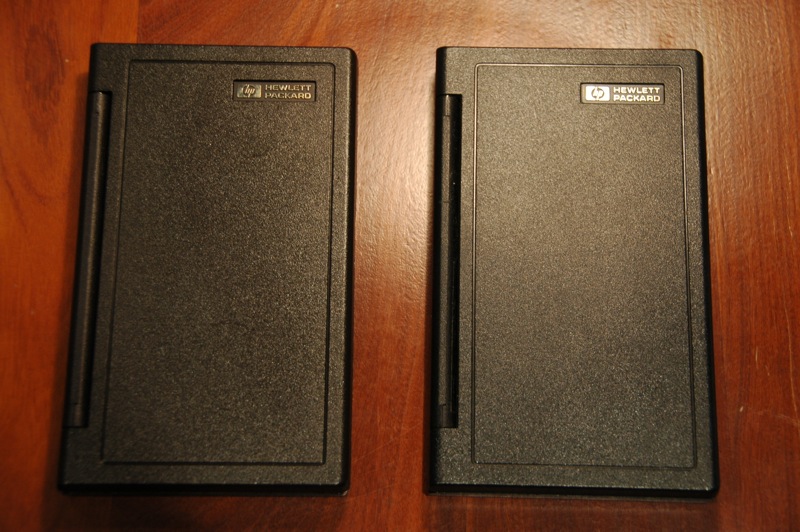
Front view: the back battery door on the right. It shows a darker colour, but the difference is not too big.
Here is the reason for getting it: the back door:
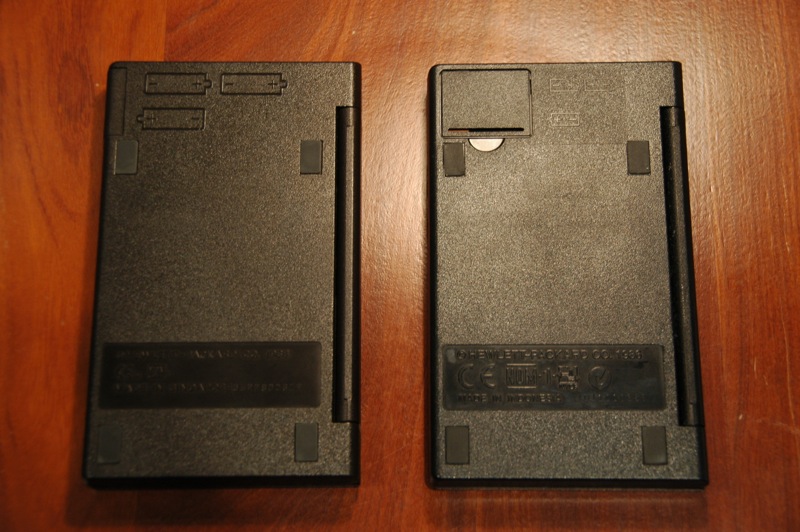
The batteries were set in place with the door, but there was pressure on the door all the time. Whoever changed a set of batteries onthese machines know what I am referring to. This design change solves the problem (at least, this problem!)
The keys have the same good key feel - totally different from any other HP but very satisfactory. This sample was made in Indonesia.
The keys are much blacker than the original:
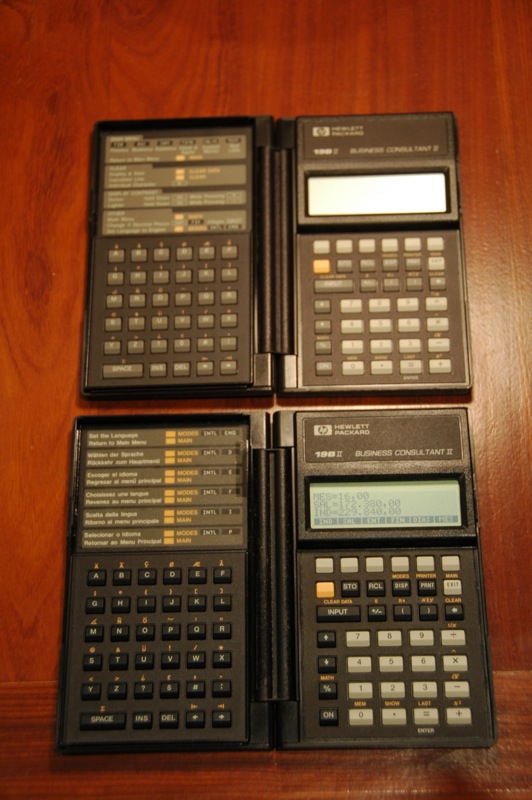
A closer look:
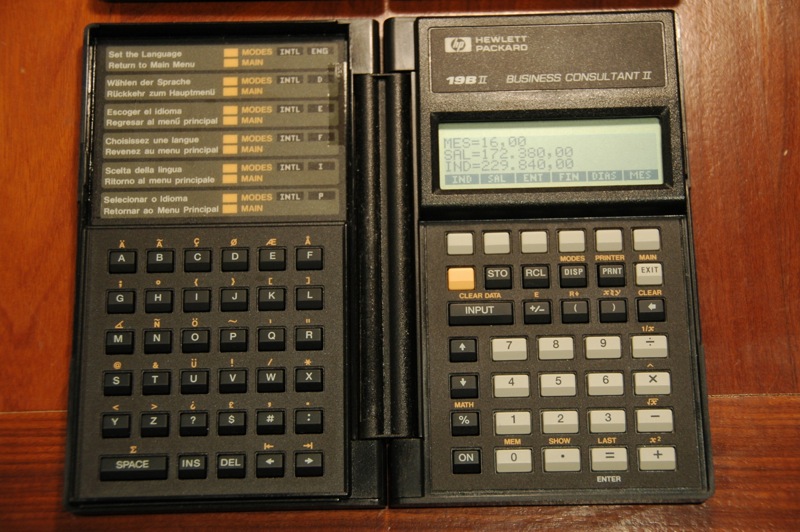
Now that I think about it, I have not tested it for speed differences - and I will not do it today. I keep most of the claculators in the collection without battery, to avoid corroding the terminals, and to do these tests I would have to go through the painful exercice of changing the batteries again...
Horses for Courses
Horses for courses...
I was thinking this when I packed my things for the summer holiday in Minorca. I had been working hard until Friday afternoon, but I left some things pending for the summer holidays (some financial analysis and the BP for the following year)
I needed to take one or more calculators with me. As many of you, I have a significant collection of calculators, so the choice is not evident at first sight. I have most of the typical calculators in the past or current line-ups - main missing item is 65-67. I hope to fill the gap sometime in the future.
Back to the packing chores. I wanted to learn more in depth the 50g, so there went a manual and the calculator. There are a number of mathematical tools that I wanted to get confident with. The 50g is a very powerful tool for a scholar - either student or professor, but I doubt that an engineer at work uses CAS or most functions at all - despite its value for a math lover. (Does a 50g really have a place in business? Yes, but you need to customise it heavily) Anyway, one for the bag. Just the doubt about taking with me a summer or winter HP50g. Let's be serious and take the winter one.
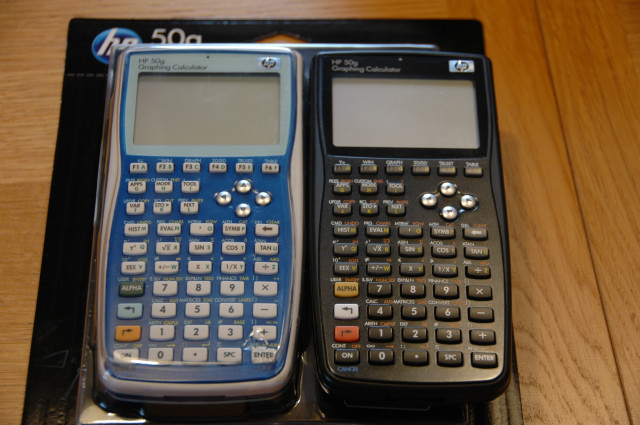
Then I took my trusty HP15c. Normally is in my jacket pocket. This time I took it with me because I wanted to create a library of programs to add to this -yours- website. You know, you need to be prepared for the rush! But this is not a calculator I'll take with me in shorts, to the beach!
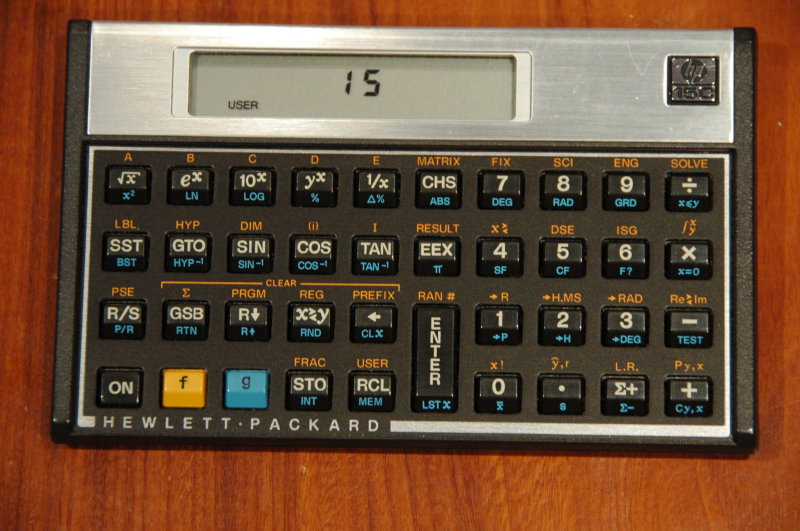
But then, there was the job I still had to do. +-/*-kind of job, with a lot of A%, %T, %, but little more. Instantaneously, I knew I wanted an HP17bII, and no other calculator. Keyboard feel would not be a factor, but screen contrast would - then I'd take the silver HP17bII+.
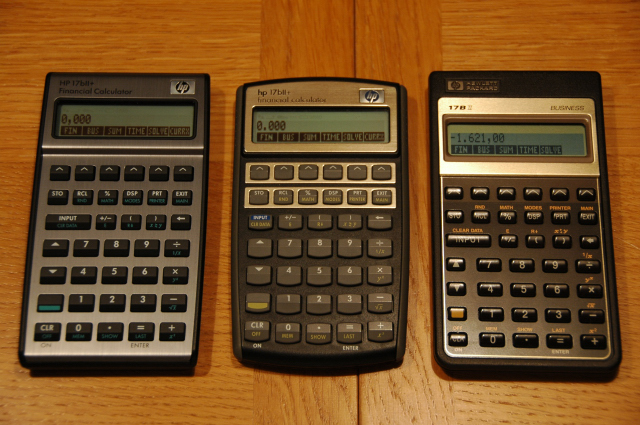
I understand that this may sound like heresy. I know that most of our readers are engineers, and a calculator without all transcendent functions is a hampered machine; but when I wanted to do number crunching in the beach, this is the calculator I wanted to have by me.
Another possibility would have been the 19bII, but its bigger real estate utilisation (and its fragility when my son drops it to the floor) were some points against.
Your mileage may vary - and that's why I said "horses for courses"
Black HP17bII
I have just received the black HP 17bII that I had been looking for.
Does anybody know when these units where made? The pictures herebelow compare it with another calculator with the typical, uglier colours. Both are made in Indonesia,but you can see the difference. Even the pouch is black instead of brown, and seems to be of better quality:
A comparison between HP 17bII, HP 17bII+ gold and HP 17bII+ silver
I wanted to check how the new designs fare when compared with the old Pioneer series. Here you have my impressions:

Key feel:
The original HP 17bII wins, hands down. Second, and not too far from it, the HP 17bII+ silver. The slanted keys of the latter are more comfortable to put the finger on, but the rounded keys of the original model are not too bad. (In the current line, I still prefer the ARM 12c but not by much)
The gold HP 17bII+ is a very distant third. There is a plastic, hollow feel to the keys that is not so agreeable as with the rest. However, there is still a healthy keystroke feedback.
I have lost a couple of keystrokes with the gold model. Not enough experience with the silver. Never with the original one.
Of course, for those of us for whom the double sized ENTER key is fundamental, the gold is again in the last position.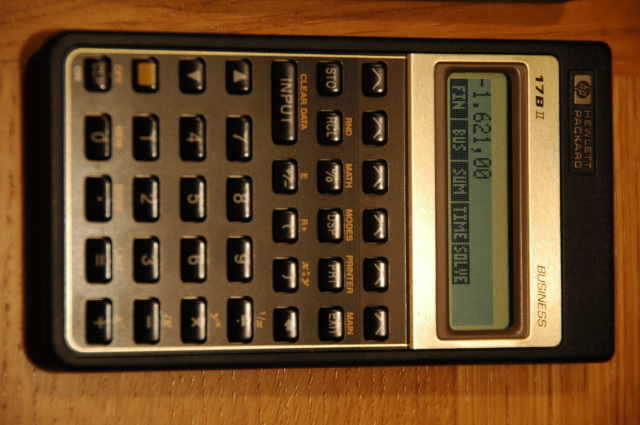
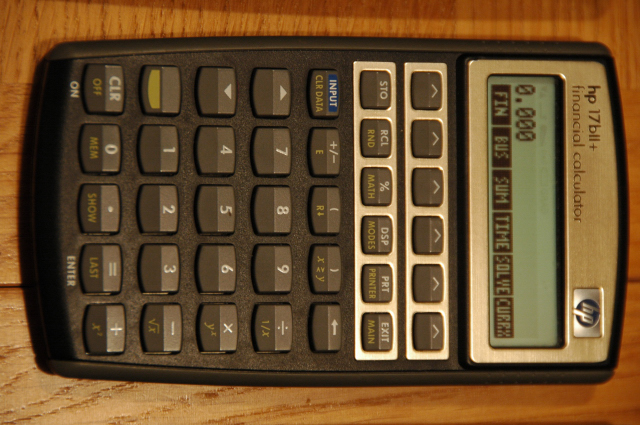

The rounded lower edges of the newer silver model make it more comfortable to handle it with a single hand. The fingers can better reach farther keys. The original's more square body makes it a little bit uncomfortable, but the thinness helps - while the gold is awkward to handle.
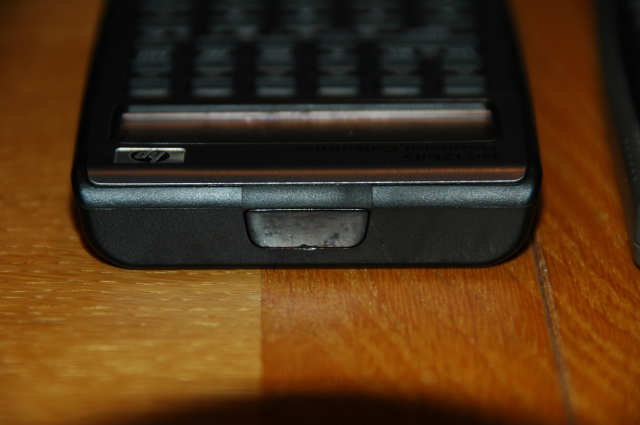
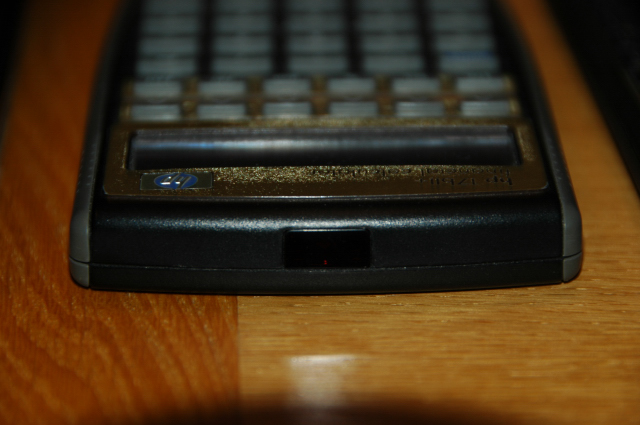
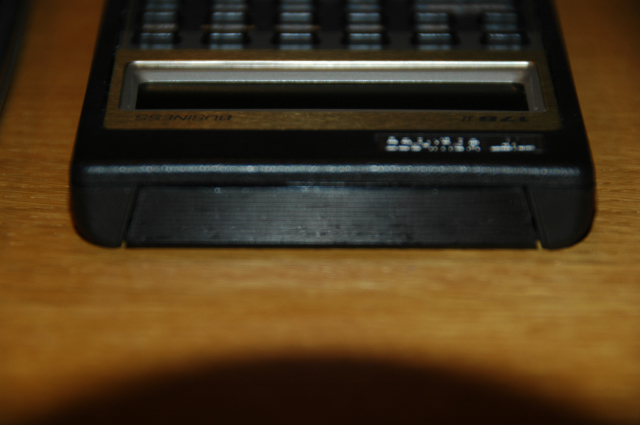
Screen
Here the ranking is: 1st silver, 2nd gold, distant 3rd the original one.
The contrast in the original is in another (lower) league.
It is worth noticing that the screen in the newer ones has provision for trigonometric modes (GRAD) and the upwards and downwards triangles - it is HP 42s- ready!!!
Functionality
I started to use this calculator around 1990, when I betrayed the engineering profession and started an MBA. It was my work calculator for the best part of 10 years, so I am quite familiar with it. At the moment, and coming from the scientific line, the fact that there were many f-keys left empty made one feel that it was an inferior product. But then we realised that the solver tool was very powerful, and that with a little ingenuity you could program most anything you needed.
This is still the case with the new models, but seemingly in the latter models some functions have been left out compared with the original (the Let and Get ones). In any case, these functions were not referenced in any manuals that I know, and were discovered by using HP 19bII programming in the 17BII.
The new models include an additional menu for currency conversion. I have 2 units of the old model (one bought in Europe and the other in America), and one has the currency exchange menu (the European one) while the other does not. However, even the European one does not handle the Euro - they could not predict it at the time!
Having the 19BII+ with RPN, it was understandable at the time to handicap the 17BII with respect to the upper model, by taking out the trigonometrics and other functions; however, now the HP 17BII is THE upper model in the range - a little effort could have been done to complete the function range of the HP 17BII with the rest of the functionality of the 19BII.
(The latter was an excellent calculator - seeing three lines of the stack was a great help to plan you calculations, but the ugly and uncomfortable layout made it difficult to be used in real life. The reliability of the battery door made it a nightmare as well - most of my friends got theirs broken, and fixed with electrical tape.)
The memory is 8 kb in the first model, 32 kb in the newer ones.
Speed
We put the following function in the solver:
A=SIGMA(I:1:5000:1:1)
HP 17bII original: 81 seconds
HP 17bII+ gold: 78 seconds
HP 17bII silver:172 seconds
The 17bII original was based on the Saturn processor, while the silver is based on the 8502 processor. It is amazing that an architecture designed in the early 80 can compete with a current production processor - until you realize that the 8502 was used...in the Commodore 128 !!!.
There is nothing new under the sun...until the ARM based machines came in!!
A final comment: For utilisation in the real world, any of them beats any other calculator in the line up. The menu logic is better than the 30b (despite its extended functionality and programmability.And you can do a lot of things more than the 12c/cp (while the latter portability makes it better for the jacket pocket)
If you can at all afford it, even after so many years, this is still the one to have!!



